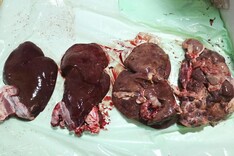Ram management
Farmers attending the ram care workshop at the recent Sheep Expo 2024 event were told of the high number of rams that fail to make it beyond their first breeding season.
While giving rams priority treatment post-breeding won’t guarantee longevity, it will greatly improve the chances of rams not falling out of the system at a young age.
Farmers were told that the first step is to remove young rams from ewes in a timely fashion. Delaying ram removal will make it difficult for them to regain body condition.
Management will depend on ram body condition and age. Where rams have lost significant condition or young rams are under pressure to meet nutritional demands for maintenance and growth, then concentrate supplementation will deliver significant benefits, particularly as the year progresses and grass quality/dry matter declines.
A standard high-energy ration, pelleted concentrate or straight cereal will suffice, with well-grown rams not having any requirement for a high-protein feed.
The overall cost to protect your investment is low.
For example, a 25kg bag of a standard high-energy ration costing €10 to €12 per bag will provide 50 to 60 days feeding at an allocation of 400g to 500g daily. Feed can be cut once rams regain sufficient condition.
Aged rams will also benefit from some preferential treatment, where required.
Temporary grazing
The need to notify the Department of Agriculture of sheep moving farms for temporary grazing depends on the farm that the sheep are moving to.
If sheep are moving to temporary grazing where livestock are present, then normal rules apply – i.e. pink copy of the document is sent to your local Department regional office for recording.
When animals return, the white copy of the document is submitted, clearly labelled ‘return from temporary grazing’.
Where sheep are moving to a holding with no livestock, then there is no requirement to notify the Department of the move. This also applies where sheep are being moved to a farm with livestock but the sheep are moving to a separate parcel of lands, e.g. an outfarm block with no livestock present.
As mentioned last week, if credit is sought for the organic nitrogen produced while sheep are grazing to reduce the farm’s stocking rate, then the Department needs to be notified of the movement.
Liver fluke
The threat of liver fluke is likely to be high again this autumn on farms along the west coast, many midlands regions and northern half of the country. The threat over the next month to six weeks will be from acute/sub-acute liver fluke and sheep ingesting large numbers of early immature larvae.
It is important that products are used that at least cover immature and mature fluke stages of the life cycle. Products with the active ingredient trichlabendazole are the obvious choice as they cover all stages, but some farms have resistance issues and therefore caution may need to be exercised.
Closantel and rafoxanide-based products target mature and immature fluke, while nitroxynil-based products are most effective against mature liver fluke.
The use of oxyclozanide-based products is generally not the first port of call advised for liver fluke, as it is the active ingredient shown to be effective against rumen fluke and the aim is to protect its efficacy with strategic use.





SHARING OPTIONS: